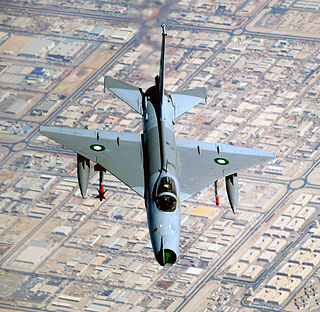
The Chengdu J-7 is a People's Republic of China fighter aircraft. It is a license-built version of the Soviet Mikoyan-Gurevich MiG-21, and thus shares many similarities with the MiG-21. The aircraft is armed with short-range, infrared homing air-to-air missiles and mainly designed for short range air-to-air combat. The aircraft is also used for close air support.

The Shenyang J-5 is a Chinese-built single-seat jet interceptor and fighter aircraft derived from the Soviet Mikoyan-Gurevich MiG-17. The J-5 was exported as the F-5 and was originally designated Dongfeng-101 and also Type 56 before being designated J-5 in 1964.

The Hongdu JL-8, also known as the Karakorum-8 or K-8 for short, is a two-seat intermediate jet trainer and light attack aircraft designed in the People's Republic of China by China Nanchang Aircraft Manufacturing Corporation. The primary contractor is the Hongdu Aviation Industry Corporation.

The People's Liberation Army Air Force, also referred to as the Chinese Air Force (中国空军) or the People's Air Force (人民空军), is an aerial service branch of the People's Liberation Army, the regular armed forces of the People's Republic of China. The PLAAF was officially established on 11 November 1949 and it is composed of five branches: aviation, ground-based air defense, radar, Airborne Corps and other support elements.

The Yakovlev Yak-18 is a tandem two-seat military primary trainer aircraft manufactured in the Soviet Union. Originally powered by one 119 kW (160 hp) Shvetsov M-11FR-1 radial piston engine, it entered service in 1946. It was also produced in China as the Nanchang CJ-5.

The Tupolev Tu-2 was a twin-engined Soviet high-speed daylight and frontline bomber aircraft used during World War II. The Tu-2 was tailored to meet a requirement for a high-speed bomber or dive-bomber, with a large internal bomb load and speed similar to that of a single-seat fighter. Designed to challenge the German Junkers Ju 88, the Tu-2 proved comparable and was produced in torpedo, interceptor and reconnaissance versions. The Tu-2 was an effective combat aircraft and it played a key role in the final offensives of the Red Army.

The Xi'an JH-7, also known as the FBC-1 Flying Leopard, is a tandem two-seat, twin-engine fighter-bomber in service with the People's Liberation Army Naval Air Force (PLANAF), and the People's Liberation Army Air Force (PLAAF). The main contractors are Xi'an Aircraft Industrial Corporation (XAC) and the 603rd Aircraft Design Institute.

The Xian H-6 is a twin-engine jet bomber of the Chinese People's Liberation Army Air Force (PLAAF). The H-6 is a license-built version of the Soviet Tupolev Tu-16 and remains the primary bomber aircraft of the People's Republic of China.

The Nanchang CJ-6 is a Chinese basic trainer aircraft designed and built by the Nanchang Aircraft Factory for use by the People's Liberation Army Air Force (PLAAF).

The Hongdu JL-10, also initially known as Hongdu L-15 Falcon, is a supersonic advanced jet trainer and light combat aircraft developed by Hongdu Aviation Industry Corporation (HAIC). It is used by the People's Liberation Army Air Force (PLAAF) as a lead-in fighter trainer (LIFT).

The Nanchang J-12 was a lightweight supersonic fighter built by the People's Republic of China, intended for use by the People's Liberation Army Air Force (PLAAF). It was one of the first serious attempts by Chinese aircraft manufacturers to develop an indigenous, modern jet fighter. Weighing 3,172 kg (6,993 lb) empty, the J-12 is one of the lightest jet fighters ever built. However, neither the J-12 nor the related Shenyang J-13 project entered service.

The Xian Y-7 is a twin turboprop transport/passenger aircraft built in China. It is based on the Soviet-designed Antonov An-24 series.
The Nanchang Q-6 is a cancelled ground attack aircraft of the People's Republic of China (PRC), with the Nanchang Aircraft Factory as the prime contractor. The project never went beyond the prototype stage, despite a prolonged development.

As of December 2017, there are 229 commercial airports in China.

The Guizhou JL-9, also known as the FTC-2000 Mountain Eagle, is a family of two-seat supersonic advanced jet trainer and light combat aircraft developed by the Guizhou Aviation Industry Import/Export Company (GAIEC) for the People's Liberation Army Air Force (PLAAF) and the People's Liberation Army Naval Air Force (PLANAF).
Nanchang (南昌) is the capital of Jiangxi Province, China
The Hongdu N-5,, originally known as the Nanchang N-5, is a Chinese agricultural aircraft. First flown in 1989, and entering into production in 1992, the N-5 is a single-engined low-wing monoplane, and is available in versions powered by a piston engine or a turboprop.

The Chinese Aviation Museum, sometimes referred to as the China Aviation Museum and the Datangshan Aviation Museum, is an aviation museum in Changping District, Beijing, China. The museum was first opened to the public on 11 November 1989, to celebrate the 40th anniversary of the founding of the People's Liberation Army Air Force.

The Xi'an Y-20 Kunpeng is a large military transport aircraft developed by the Xi'an Aircraft Industrial Corporation for the People's Republic of China (PRC).















